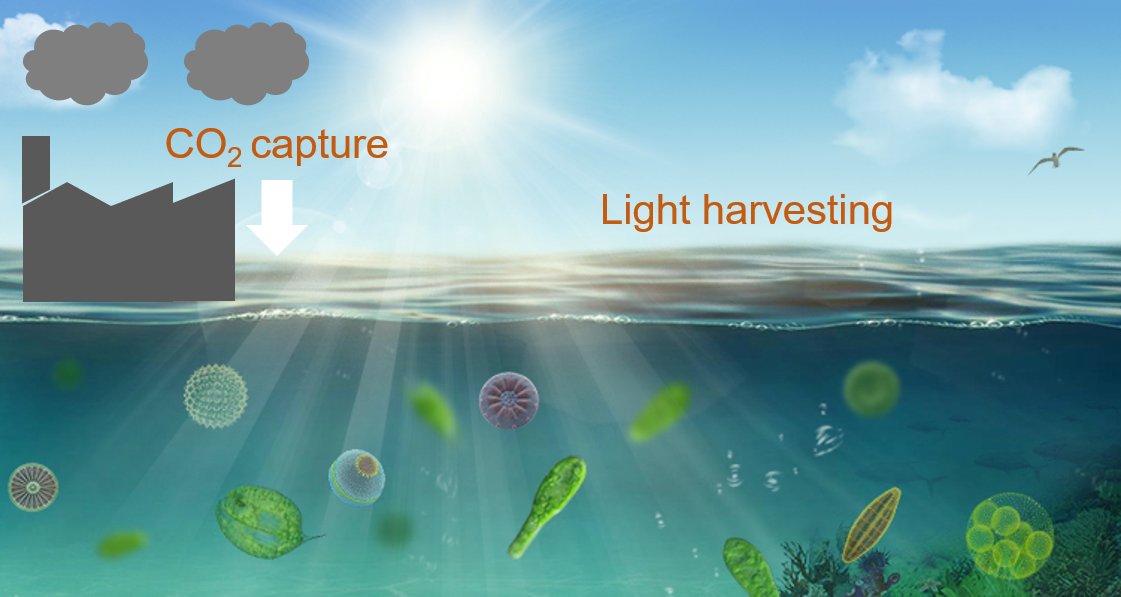
碳排放已成为制约我国经济持续发展、影响国家安全的重大瓶颈。与以物理封存与化学吸收为基础的碳捕获技术相比,以微藻为代表的光驱固碳体系具有明显的优势。作为地球上最主要的初级生产者,藻类通过光合作用,将光能和二氧化碳转化为化学能,贡献了海洋初级生产力的95%和全球初级生产力的近50%,在生物圈碳循环和生态平衡过程中扮演着重要的角色。近日,海南大学南海海洋资源利用国家重点实验室、海洋学院在海洋微藻光合机制研究取得重要进展,发现了一种崭新的基于光系统I捕光天线的“光利用”与“光损伤”平衡的调控机制。该工作于1月29日在线发表于Nature Communications。
Carbon emission has become a major bottleneck that restricts China's sustainable economic development and affects its national security. Compared with carbon capture technology based on physical sequestration and chemical absorption, the light-driven carbon fixation system represented by microalgae has obvious advantages. As the main primary producer on earth, algae contribute 95% of marine primary productivity and nearly 50% of global primary productivity through photosynthesis which converts light energy and carbon dioxide into chemical energy, playing an important role in the process of biosphere carbon cycle and ecological balance. Recently, MRU and the School of Ocean of Hainan University have made an important progress in the research of photosynthesis mechanism of marine microalgae and discovered a new regulatory mechanism of the balance between “light utilization” and “light damage” based on photosystem I light trapping antenna. The result was published online on January 29, 2021.
捕光天线是自然界中捕获光能、固定二氧化碳最主要的蛋白质分子机器。为了最大程度地利用太阳能并防止过剩光能造成光损伤,微藻进化出了多样的遗传机制和复杂的表型可塑性。在高度变化的海洋环境中保持这种平衡具有极高的挑战性。能量的捕获(阳光)及其使用(通常是碳固定和新陈代谢)受多种连续变化的参数(例如日射率,温度条件和养分)的影响。真核藻类的光捕获复合物(LHC)中已演化出巨大的结构和功能多样性,从而实现在各种光照条件下的光捕获与光保护的平衡(Qin et al., Nature Plant 2019; Wang et al., Science 2019)。RL系真核藻类(red lineage)起源于一次内吞红藻或多次内吞事件,它们具有称为LHCR的叶绿素a结合蛋白,该系统代表了在红藻中进化形成并通过继发性内共生而获得的古老的天线蛋白形式。然而LHCR复合体的功能和调节机制一直是科学界的未解之谜。
Light-trapping antennas are the most important protein molecular machines in nature for capturing light energy and fixing carbon dioxide. Microalgae have evolved diverse genetic mechanisms and complex phenotypic plasticity to maximize the use of solar energy and prevent photodamage caused by excess light energy. But maintaining this balance in a highly variable marine environment is extremely challenging. Energy capture (light) and its use (usually carbon fixation and metabolism) are influenced by a variety of continuously varying parameters (e.g. solar irradiance, temperature conditions and nutrients). A great structural and functional diversity has evolved in the LHC of eukaryotic algae, resulting in a balance between light trapping and photoprotection under various light conditions (Qin et al., Nature Plant 2019; Wang et al., Science 2019). The eukaryotic algae of the RL (red lineage) originate from a single endocytosis of red algae or multiple endocytoses. And diverse algae of the red lineage possess chlorophyll a-binding proteins termed LHCR, comprising the PSI light-harvesting system, which represent an ancient antenna form that evolved in red algae and was acquired through secondary endosymbiosis. However, the function and regulation of LHCR complexes remain obscure.
海南大学南海海洋资源利用国家重点实验室、海洋学院环境微生物团队以海洋微拟球藻(Nannochloropsis oceanica)为模式,通过定向进化、蛋白质组等分离并表征了一株名为hlr1的LHCR突变体。HLR1缺失减弱了PSI的光捕获能力,但提高了对强光(HL)的耐受力。进一步的研究表明,突变体对HL耐受性的提高归因于光系统I(PSI)的变化,使其不易产生活性氧,从而限制了氧化损伤,进而有利于其HL下的生长。同时,该蛋白具有广泛的进化分布和相对保守功能,在光保护与光利用之间的动态平衡过程中起到关键的作用。相关机制的发现为开发调控“光利用”与“光损伤”平衡的合成生物学方法提供了理论支撑。
The Environmental Microbiology Team consisting of experts from MRU and the School of Ocean of Hainan University isolates a Nannochloropsis oceanica LHCR mutant, named hlr1, which exhibits a greater tolerance to high-light (HL) stress compared to the wild type through targeted evolution and proteome. The result shows that increased tolerance to HL of the mutant can be attributed to alterations in PSI, making it less prone to ROS production, thereby limiting oxidative damage and favoring growth in HL. HLR1 deficiency attenuates PSI light-harvesting capacity and growth of the mutant under light-limiting conditions. It can be concluded that HLR1, a member of a conserved and broadly distributed clade of LHCR proteins, plays a pivotal role in a dynamic balancing act between photoprotection and efficient light harvesting for photosynthesis. The discovery of the relevant mechanism provides theoretical support for the development of synthetic biology methods to regulate the balance between light utilization and light damage.
该研究获得了国家自然科学基金(32060061)、自然资源部海洋经济创新发展示范项目(HHCL201803)、南海海洋资源利用国家重点实验室开放课题(MRUKF2021003)、海南省自然科学基金高层次人才项目(2019RC033)、海南大学科研启动经费(KYQD1561)和海南省委“南海名家”青年学者等项目的支持,海南大学作为第一单位,由南海国重、海洋学院路延笃教授联合美国劳伦斯伯克利国家实验室分子生物物理学和生物影像中心、伯克利大学、霍华德休斯医学研究所等完成,并得到中国科学院青岛生物能源与过程所徐健研究员、河南大学张立新教授和中国科学院植物所杨文强研究员等的帮助。
The paper was completed under the help of Dr. Xu Jian (Qingdao Institute of BioEnergy and Bioprocess Technology, Chinese Academy of Sciences), Professor Zhang Lixin (Henan University) and Yang Wenqiang (Institute of Botany, Chinese Academy of Sciences).And it was also supported by the funding from the National Natural Science Foundation of China (32060061), the Basic and Applied Basic Research Programs for the Talents of Hainan Province (grant no. 2019RC033), the Project of Innovation & Development of Marine Economy (grant no. HHCL201803), the Foundation of Hainan University (grant no. KYQD1561), and the Project of State Key Laboratory of Marine Resource Utilization in South China Sea (grant no. MRUKF2021003), Molecular Biophysics and Integrated Bioimaging Division of Lawrence Berkeley National Laboratory and Howard Hughes Medical Institute.

文章链接:https://www.nature.com/articles/s41467-021-20967-1
Link to full text: https://www.nature.com/articles/s41467-021-20967-1
 公众号
公众号